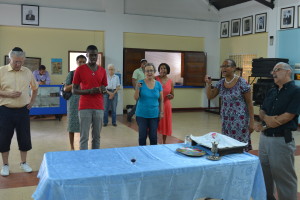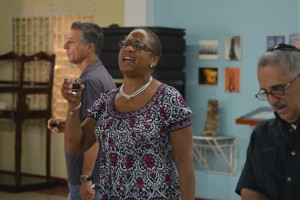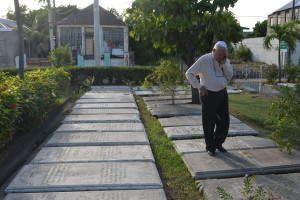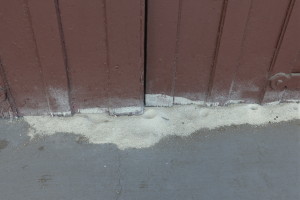There were as many as eight synagogues and roughly 2,500 Jews in Jamaica in the 1800s. But tides of migration and assimilation have now left only 200 congregants, and just one synagogue remains.
By: David McFadden/AP

Congregants and visitors hold glasses of wine and sing in the cultural heritage center of Jamaica’s last synagogue. (Photos: AP/David McFadden)
It’s Saturday morning at Sha’are Shalom, but there aren’t enough Jews gathered in the dim light of Jamaica’s only synagogue to conduct a formal prayer service.
An American tourist watches near the entrance of the historic temple as a half dozen members of Jamaica’s dwindling Jewish community instead perform informal Sabbath prayers led by a congregant. Without the 10 Jewish adults needed for a quorum known as a minyan, men and women gather around a mahogany platform raised above a sand-covered floor to pray and sing to the swelling chords of a pipe organ.
“I had to see this temple for myself,” said the tourist, Melissa Solomon, a former Hebrew teacher visiting from Pawtucket, Rhode Island, with her toddler son. “I thought, ‘Jamaica, too, has Jews?'”
In Jamaica in the 1800s, there were as many as eight synagogues and roughly 2,500 Jews, including quite a few who had a notable influence on civic life. But tides of migration and assimilation have dropped their numbers to roughly 200 congregants, and just the one temple remains.
With most members of the congregation now older than 50, its members are trying to preserve their history and attract tourists who can appreciate it. In an incipient attempt to develop Jewish-related tourism on the island, the Jamaica Tourist Board says it’s cultivating a “Jewish Jamaica” travel package as a form of “heritage tourism” that could encourage visitors to hold family celebrations such as weddings and bar and bat mitzvahs here.

Marie Reynolds holds a glass of kosher wine and leads a handful of congregants and visitors in song.
Community leader Ainsley Henriques says the Kingston synagogue evolved out of Sephardic conservative traditions from the Iberian peninsula but adopted liberal practices from British and American Reform movements. His younger cousin Stephen Henriques leads the religious services in the absence of a rabbi and is the legal marriage officer for the Jewish community in Jamaica.
No one expects Jamaica’s tiny Jewish population to rebound, but community members say they hope to preserve what remains.
“Regardless of what happens in the future, I want people to always know that Jews were indeed here,” said the elder Henriques, who leads efforts to showcase the Jamaican community’s traditions and draw visitors by hosting Jewish history conferences, opening a small museum next to the Kingston synagogue and trying to restore centuries-old Jewish cemeteries.
“Jewish tourism is lively, serious and always searching for new destinations. … It may help the fragile community in Jamaica in its strong desire to persist,” said Jane Gerber, director of the Institute for Sephardic Studies at City University of New York and editor of the 2013 book “The Jews in the Caribbean.”
Tourism highlighting Jewish Caribbean heritage has provided badly needed financial and other support to tiny Jewish communities elsewhere in the region, including St. Thomas in the U.S. Virgin Islands and the Dutch Caribbean island of Curacao — both of which benefit from being cruise ship destinations.

Jewish community leader Ainsley Henriques walks on historic gravestones engraved with Hebrew inscriptions.
Each year, about 40 bar and bat mitzvahs for overseas Jews are held in the U.S. Virgin Islands’ historic synagogue, which experts say is largely supported by “snowbirds” escaping winter in the northern U.S. “It is an important revenue stream for us,” said Mina Orenstein, the temple’s events coordinator.
As many as 10,000 visitors, mostly cruise ship tourists, pass annually through Curacao’s Mikve Israel-Emanuel and more than a dozen of the coming-of-age rituals are held there each year, said the synagogue’s president, Kenneth Godschalk. Founded in 1732, it is believed to be the oldest continuously operating temple in the Western Hemisphere.
The Jamaican Jewish community’s biggest challenge for promoting tourism has been the sole temple’s location in Kingston. The southern city attracts few of the tourists who flock to scenic beaches on the northern side of the island of 2.7 million. A four-hour drive from the Montego Bay resort, Kingston has no tourist beach to speak of and has long struggled with a high rate of violent crime.
“Kingston has a reputation of not being so safe, so people are nervous to travel there,” said Ellen Paderson, who runs a Massachusetts travel agency called Bar Mitzvah Vacations. She largely works with the synagogue in St. Thomas.
Jamaica’s Jewish community is tightly knit with a strong sense of history — in large part because of Henriques’ work, including his efforts to preserve the community’s memories through his Jamaica Jewish Genealogical Institute.

White sand spills out from the closed wooden doors of the synagogue. Jews came to Jamaica with Spanish and Portuguese settlers in the 1500s. They were “conversos,” who pretended to convert to Catholicism to save their lives during the Spanish Inquisition. Some scholars say the sand on the floor signifies the attempt by Spanish Jews to muffle the sound of worship to avoid detection.
Jews came to Jamaica with Spanish and Portuguese settlers in the 1500s. They were “conversos,” who at least pretended to convert to Catholicism to save their lives during the Spanish Inquisition. Some scholars say the sand on the floor of Sha’are Shalom in Kingston, as well as the other Caribbean temples, signifies the attempt by Spanish Jews to muffle the sound of worship to avoid detection.
According to “Jewish Pirates of the Caribbean” by Edward Kritzler, an American writer who worked for Jamaica’s tourist board and promoted the island’s Jewish history, some Sephardic Jews became pirates who plundered galleons. Jewish merchants settled in growing towns, including Port Royal, a notorious stronghold for pirates that was Jamaica’s main city until an earthquake and tsunami leveled it in 1692.
Under British rule, Jews formed the core of Jamaica’s merchant class. In 1831, colonial Jamaica gave voting rights to Jews, years before they obtained the same rights in Britain. By the late 1840s, eight of the 47 members of the House of Assembly were Jewish.
The remaining Jamaican Jews improvise to keep traditions alive. While there is no kosher butcher shop on the island, a U.S. couple with the Hasidic movement Chabad Lubavitch recently moved to Montego Bay to prepare kosher dinners and lead prayers for Jews passing through.
Occasionally, some people in the largely Christian nation look to join the faith, like 18-year-old Mickel Hylton. For three years, he has attended temple services and avoids pork with the intention of completing the lengthy conversion process.
“Judaism speaks to me,” Hylton said. “I hope to be a Jew until the day I die.”
___
If you go….
SHA’ARE SHALOM SYNAGOGUE: 92 Duke St., downtown Kingston, Jamaica, https://www.ucija.org . Adjacent is heritage center and courtyard with historic gravestones. Schedule visits: 876-922-5931. Hours: 9 a.m.-4 p.m. Monday-Thursday.




